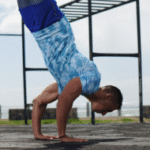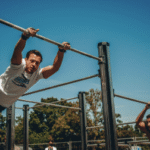Muscle-Ups: The Ultimate Calisthenics Challenge
The muscle-up is a dynamic and impressive feat of strength that combines a pull-up and a dip into one fluid movement. It’s a challenging exercise that requires significant upper body strength, explosive power, and coordination. This guide will delve into the benefits, proper form, progressions, and training tips to help you conquer this ultimate calisthenics challenge.
Why Muscle-Ups are the Pinnacle of Bodyweight Mastery:
Full Upper Body Engagement: Muscle-ups work your entire upper body, including your lats (back), traps (upper back), biceps, triceps, chest, and shoulders.
Explosive Power: They require explosive pulling power to transition from the pull-up to the dip phase, enhancing your overall athleticism.
Coordination and Timing: Muscle-ups demand precise coordination and timing to execute the movement smoothly and efficiently.
Increased Strength and Muscle Mass: They build significant strength and muscle mass in your upper body, surpassing standard pull-ups and dips in difficulty.
Functional Strength: Muscle-ups translate to real-world pulling and pushing movements, making you stronger and more capable in various activities.
Mental Toughness: Mastering muscle-ups requires dedication, discipline, and mental focus, building mental resilience alongside physical strength.
Impressive Skill: Performing a muscle-up is a visually impressive feat of strength and control, demonstrating mastery over your body.
Mastering the Muscle-Up:
Prerequisites: Before attempting muscle-ups, you should have a solid foundation in pull-ups and dips. Aim to be able to perform at least 8-10 strict pull-ups and 15-20 dips with good form.
False Grip: The false grip is crucial for muscle-ups. Instead of gripping the bar with your fingers wrapped around it, place your wrists on top of the bar, allowing your hands to fold over. This grip helps with the transition from the pull-up to the dip.
The Movement:
Explosive Pull: Start with a powerful pull-up, bringing your chest towards the bar.
Transition: As you reach the top of the pull-up, use your momentum and core strength to transition your body over the bar.
Push to Dip: Once your chest is above the bar, push yourself up into a dip position.
Lower Down: Slowly lower yourself back down to a hanging position, maintaining control.
Common Mistakes to Avoid:
Weak Pull: Generate enough explosive power in the pull-up phase to transition over the bar.
Lack of Core Engagement: Engage your core throughout the movement to maintain stability and control.
Incorrect Grip: Use the false grip to facilitate the transition.
Rushing the Movement: Focus on smooth and controlled transitions between the pull-up and dip phases.
Muscle-Up Progressions:
Jumping Muscle-Ups: Use a box or platform to jump and assist with the transition over the bar.
Negative Muscle-Ups: Start at the top of the muscle-up (in the dip position) and slowly lower yourself down with control.
High Pull-Ups: Practice pulling your chest as high above the bar as possible to develop the necessary pulling strength.
Explosive Dips: Perform explosive dips to build the pushing power needed for the transition.
Tips for Success:
Gradual Progression: Start with easier progressions and gradually work your way up to full muscle-ups as your strength and coordination improve.
Focus on Form: Prioritize proper form over the number of repetitions.
Listen to Your Body: Rest when needed and avoid pushing yourself too hard, especially when starting.
Warm-Up: Prepare your shoulders, wrists, back, and chest with dynamic stretches and light exercises before doing muscle-ups.
Consistency is Key: Incorporate muscle-up progressions into your workout routine regularly to see consistent progress.
Bonus Resources:
YouTube Tutorials: Search for “muscle-up progressions” or “how to do muscle-ups correctly” on YouTube.
Calisthenics Communities: Join online forums or groups dedicated to calisthenics for support, motivation, and advice.
Certified Trainers: Consider working with a certified calisthenics trainer for personalized guidance and feedback.
By mastering muscle-ups and incorporating them into your training, you’ll unlock a new level of upper body strength, power, and coordination. So, embrace the challenge, refine your technique, and conquer this ultimate calisthenics skill!

Muscle-Ups: The Ultimate Calisthenics Challenge
Route
Calisthenics Gym Houston Functional Bodyweight Training
Secondary phone: (346) 483-3195
Email: info@calisthenicsclubhouston.com
URL: https://calisthenicsclubhouston.com/
Monday 6:00 AM - 7:00 PM Tuesday 6:00 AM - 7:00 PM Wednesday 6:00 AM - 7:00 PM Thursday 6:00 AM - 7:00 PM Friday 12:00 PM - 6:30 PM Saturday 9:45 AM - 12:00 PM Sunday 3:00 PM - 5:00 PM





